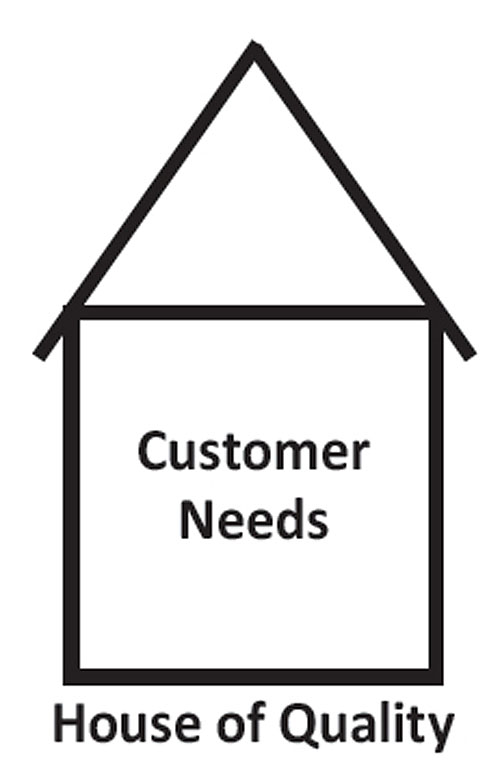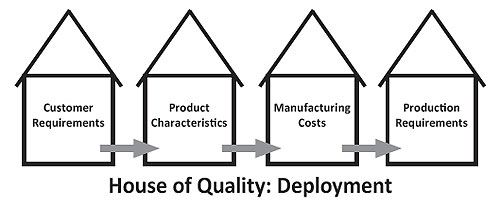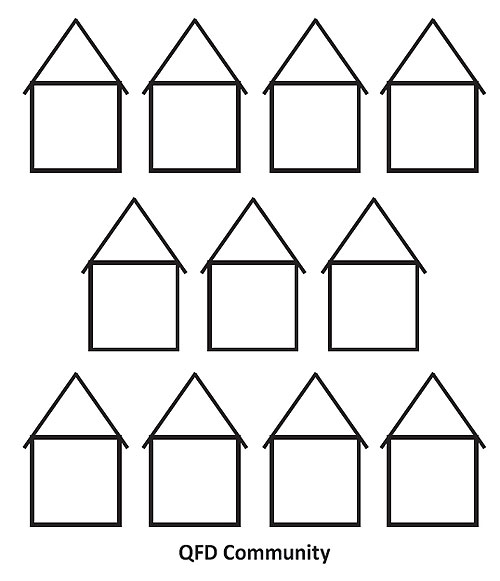The Value of QFD in New Product Development
by Perry Parendo
Perry's Solutions, Inc.
There are many tools available for people in new product development. With Design of Experiment (DOE), Earned Value Management (EV), Design for Manufacture and Assembly (DFM&A), Failure Mode and Effects Analysis (FMEA) and Theory of Inventive Problem Solving (TRIZ), the options are endless.
Yet, with extreme pressure on organizations to achieve deadlines, one cannot just "try them out" to see what happens. There needs to be confidence in the tool as a productive use of time. Quality Function Deployment (QFD) is one tool that appears to have interest because of the potential and need, but often is left on the sidelines. Does it have value? How can the value be accessed? And, what is QFD anyway?
What is QFD?
Per the ASQ website (asq.org): Quality professionals refer to QFD by many names, including matrix product planning, decision matrices and customer-driven engineering. Whatever you call it, QFD is a focused methodology for carefully listening to the voice of the customer and then effectively responding to those needs and expectations. First developed in Japan in the late 1960s as a form of cause-and-effect analysis, QFD was brought to the United States in the early 1980s. It gained its early popularity as a result of numerous successes in the automotive industry.
Three schools of QFD thought
If you are familiar with QFD, you likely are aware of the "House of Quality" approach. This is focused on what the customer needs and how your organization will accomplish them. It also can contain a "contradiction" matrix to understand risky and potentially challenging areas. It requires thinking in the customer’s shoes, plenty of brainstorming and then the dreaded scoring. Is the effort worth it for a team of people? It depends on the maturity of the product. For brand new items, it can be useful. Yet, if it is too new, then people may not understand the value of the future new product yet. Thus, it is best as a needs-driven development tool, but not for disruptive innovations.
The second school of thought is an extension of the "House of Quality." This is where the deployment takes place. The customer requirements flow into the design product characteristics, the design into the manufacturing process and manufacturing into the production requirements. Most will start with the first House of Quality from above, lose steam and be done. Yet, the organization is sold on the original vision of completing all four houses. Resources are not supplied, and the needed value may or may not have been achieved.
There is a third, lesser known approach to QFD – the "QFD Community" method. It was the writings of Bob King that provided the first US exposure to this approach. Simply put, it is a series of matrices. There are over 30 matrices to choose from in this method, which can expand or change depending on the situation. This QFD Community methodology goes beyond just the one "house." A key conceptual difference is that you pick a "path" through the system based on the needs of the project. You do not have to visit everyone in the "community," Instead, you can visit who you want to or need to! For example, you can identify critical parts, identify breakthrough methods or set cost targets. By working on the priority matrices first, if resources are reassigned, you still are able to obtain value from the methods.
Weaknesses of any QFD tool
Regardless of the QFD tool used, there are three general weaknesses that exist: the time required to complete the task, the scoring process and the facilitation of the overall QFD process.
Time. Most of these tools require a team with times spent together to brainstorm and score them. This often is during a time on the project when there is so much "obvious" work to get done. People are compelled to get work started, so they can improve the chances of meeting the impending deadlines and often are reluctant to spend time and money on anything that could be considered as an extra. For instance, a group may jump into working on the components that require long lead time tooling. QFD makes sense, but what if that component does not meet what the customer needs? Including QFD will either lengthen the project or disappoint the customer. Prioritizing the QFD tools helps to resolve this concern.
Scoring. When numbers are involved, there is a chance for inconsistencies or manipulation. This creates uncertainty with the team. On a new project, the team just recently formed and trust has not been established. The value of the QFD results is limited until trust is strongly established. Plus, the basic framework of the tool may allow unintentional bias. For instance, if scoring a new product idea with 14 performance requirements, two cost constraints and one schedule item, performance always is going to win. There are multiple ways to address this, but the leader needs to be aware of this risk related to tool setup. One way to handle this is to use a small team to create it and review with a larger group (including busy experts) to edit it when they are available.
Thinking styles and facilitation. When one tool involves both brainstorming (open-ended thinking) and deterministic thinking (i.e. scoring or down selecting), this is disruptive to a group. This change of mental gears is visible and frustrating. Some facilitators will bounce between both activities: talk, score, talk, score, etc. That style is highly inefficient. Others will talk first and score second, but without a noticeable break in activities. I personally prefer to end the brainstorming session and schedule the scoring for one week later. This allows content to be adjusted during scoring as new ideas appear, but the focus is on one style of thinking.
It is important that the leader can think both ways. It also is important the leader is not biased regarding the final outcome. Otherwise, the work already started will be wasted if a new direction is chosen. Why not use the tool early and gain the leverage needed? This also increases engagement of the team knowing that the direction is "firm" and not subject to random changes from outside influences.
Project examples
Below are two examples of applications using the QFD tools. Making fast and confident decisions benefited each example. Would similar benefits create an advantage for a project you are working on?
Evaluation of conceptual options. While working on a project with the Army, there were strong opinions about the right technical approach for one area of the design, resulting in nine months of conflict. Using the Pugh Concept selection tool, many design options were presented and discussed in just a few weeks. Prior to this point, each side had a pet solution and neither was willing to bend. It was not easy to see the tradeoffs.
The approach used was able to open up the situation and allowed the team to rewrite a high-level requirement to allow multiple solutions. Ideas were solicited from a wide range of people, and a small core group performed the scoring. Within a few weeks, this was agreed to and implemented as the new design guidance. This allowed the detailed engineering to begin and provided support to the solution that best balanced all of the design requirements.
Technical breakthrough. While working on a unique new product application, the opportunity for a creative solution would be important. When reviewing the QFD Community matrix options and the project need list (shown later in this article) early on in the project, the technical breakthrough topic struck a chord. After going through a few of the matrices in that category, a light bulb clicked regarding the solution! This led to a patentable solution that was not considered prior to the QFD effort. That sudden rush of energy and thinking has happened a few times in my career, and I believe these tools made it happen in this case.
What next?
A team cannot decide to use QFD on a project any more than it can decide to use a hammer. The need has to exist first. This is why the QFD Community approach is appealing. It covers more needs and has a range of methods for implementation. What are the needs that QFD can address?
Project Need List
- Analyze customer demands
- Critique functions
- Set quality characteristics
- Identify critical parts
- Set breakthrough targets
- Set cost targets
- Set reliability targets
- Select new concepts
- Identify breakthrough methods
- Identify manufacturing methods
The items in the checklist above are process steps in new product development. If an item is important for a specific project, then the team should find and use the related tools. Many situations do not require the depth available in the QFD tools. Yes, it may provide a benefit, but is it worth the time? In most projects, a few tools will be used on each project, but never will all be used on a single project. In fact, some tools can be used by an individual on a simple decision rather than always forcing a large team to take on the entire project.
Each project need area has more tool options than are available with the QFD Community approach. It is a nice starting point though. If you need to go further (i.e. identify breakthrough methods), then one may consider brainstorming/creativity tools, TRIZ or many other "non-matrix" approaches.
Understand the project needs first – do not follow a random process or use a tool because "that sounds useful." This QFD framework and project needs list simply provide a starting point to effectively obtain the benefits available for the early stages of new product development.



